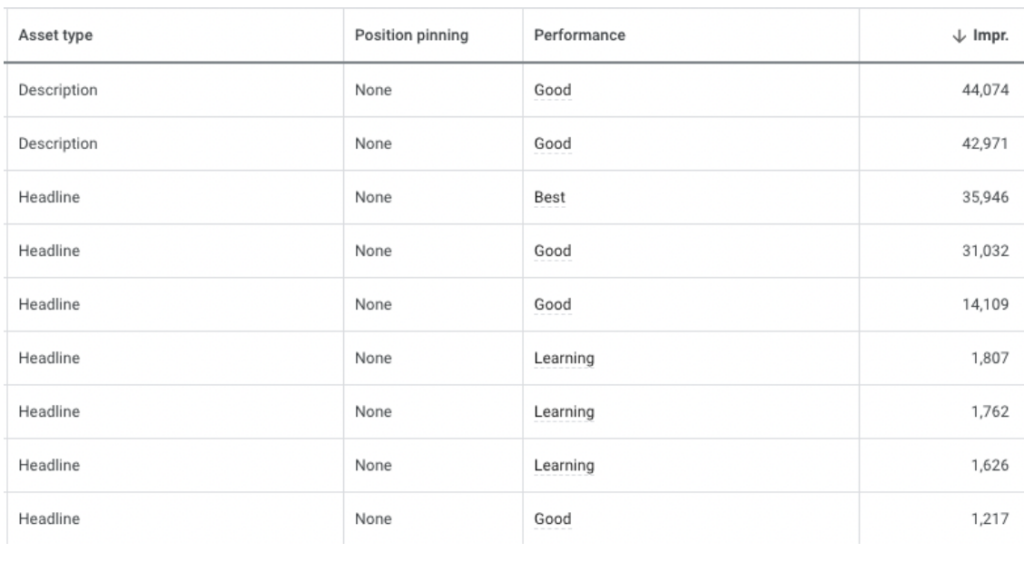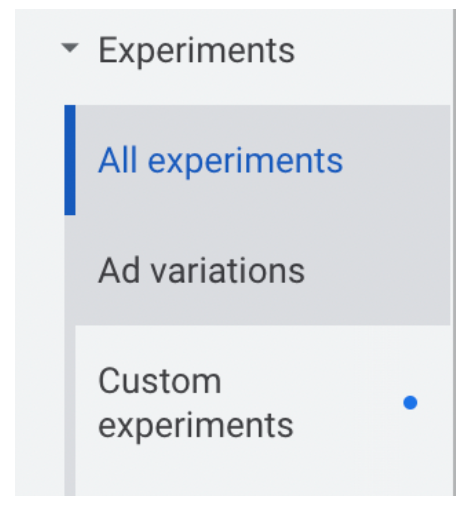Article originally published on Search Engine Land.
As machine learning seizes yet another opportunity to beat out human capabilities, Google Ads is officially retiring Expanded Text Ads (ETAs) on June 30.
The simple days of three headlines and two descriptions will be replaced by mix-and-match opportunities of up to 15 headlines and four descriptions.
Advantages to running Responsive Search Ads (RSAs) include:
However, trust concerns arise when advertisers use these algorithms. RSA reporting leaves much to be desired, as you can only see the number of impressions for each asset and combination.
Does the lack of control over ad copy combinations leave you questioning if there’s more you can do to optimize performance?
Read on to discover four ways to improve RSA conversion rates – with test findings to back them up.
Google provides impression volume for each headline and description.
If you’re receiving enough volume (over 5,000 impressions in 30 days), then the algorithm may be able to assign a performance rating to your ad copy.
The ratings include:
While it is recommended that you replace a “low” performing asset with a new variation to improve CTR, impression volume is simply not enough to dictate a true winner.

Click and conversion volume are the missing links in this report. To put our trust behind RSAs, we need to ensure they are supporting our goals.
CTR and CVR are critical to analyzing performance on campaigns with conversion goals as well as low-volume ad groups where it may be impossible to get out of the learning phase.
We need to test two RSAs against one another to look at ad-level KPIs, not just copy-level impressions. Ad copy in each RSA should be intentionally limited to just three headlines and two descriptions and the ads should be tested in an experiment.
In this way, you are creating pseudo-ETAs. Once you start recognizing winners, you can optimize performance by turning off poor-converting assets in your non-experimental RSAs.
When comparing ETAs and RSAs, advertisers often see higher CTR in RSAs but lower CVR.
This could be caused by the lack of messaging control and Google’s push for advertisers to follow best practices to improve their ad strength.
In order to bring your RSA ad strength from Poor to Excellent, Google wants to create and test as many ad copy combinations as possible, recommending:
While following best practices is said to be optimal for performance, advertising rebels should run their own tests. Manual testing can continue after ETAs disappear.
To test how much ad strength impacts conversion rate, we set up an experiment in Google for two weeks:
Client A is on a tCPA bidding strategy and needs to get the most efficient CPL possible.

Both the control and test showed similar results. With a goal of lower CPL, pinning the headlines and descriptions would be a better decision to optimize this ad group’s performance.
Now that we know we can pin ad copy without any repercussions to our CPL or CVR, we can think about the proper way to A/B test headline and description variations.
When leveraging smart bidding tactics, algorithms are doing what they can to help you reach your goals. Even when you check the Do not optimize ad rotation option in the settings, Google is not serving your ads evenly because it is working to satisfy your campaign goals first.
Knowing that Google will favor one RSA over another if you run two RSAs in one ad group simultaneously, gaining true KPIs on each ad copy variable is difficult when impression volume is so skewed.
The best way to test one variable at a time is to set up a custom experiment or ad variation. This will ensure that the spend gets split 50/50 for each ad.

Although this test defeats the purpose of Google’s ETA exile, you can offer just three headlines and two descriptions per ad.
Testing two pseudo-ETAs in an experiment is a great way to analyze winning ad copy.
In this experiment, we looked at giving the algorithm some freedom while maintaining control of our messaging:
Client B is on a tCPA bidding strategy and needs to get the most efficient CPL possible.

Trusting the algorithms can be an easy way to test multiple ad copies simultaneously. However, with some extra experimenting and detective work, humans can optimize conversion rates even further than machine learning.
*Featured photo by Rubaitul Azad on Unsplash
All the latest digital advertising tips and industry insights delivered to your inbox every quarter

Not sure if your paid media team is built to scale—or stuck in last year’s playbook? Use this paid media hiring guide to quickly evaluate your inherited agency, freelancers or internal team so you can make the right call for your goals.

Google is doubling down on AI-first advertising strategies in 2025. Here are the four trends from Google Marketing Live that advertisers must act on.

Closed Loop and Clover earned three Silver Telly Awards for the “Behind the Business” campaign, celebrating standout creative across CTV and digital.